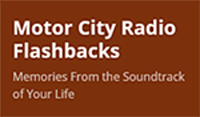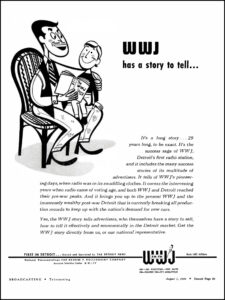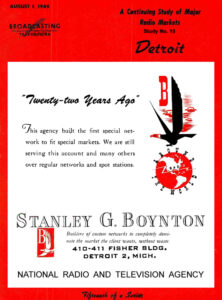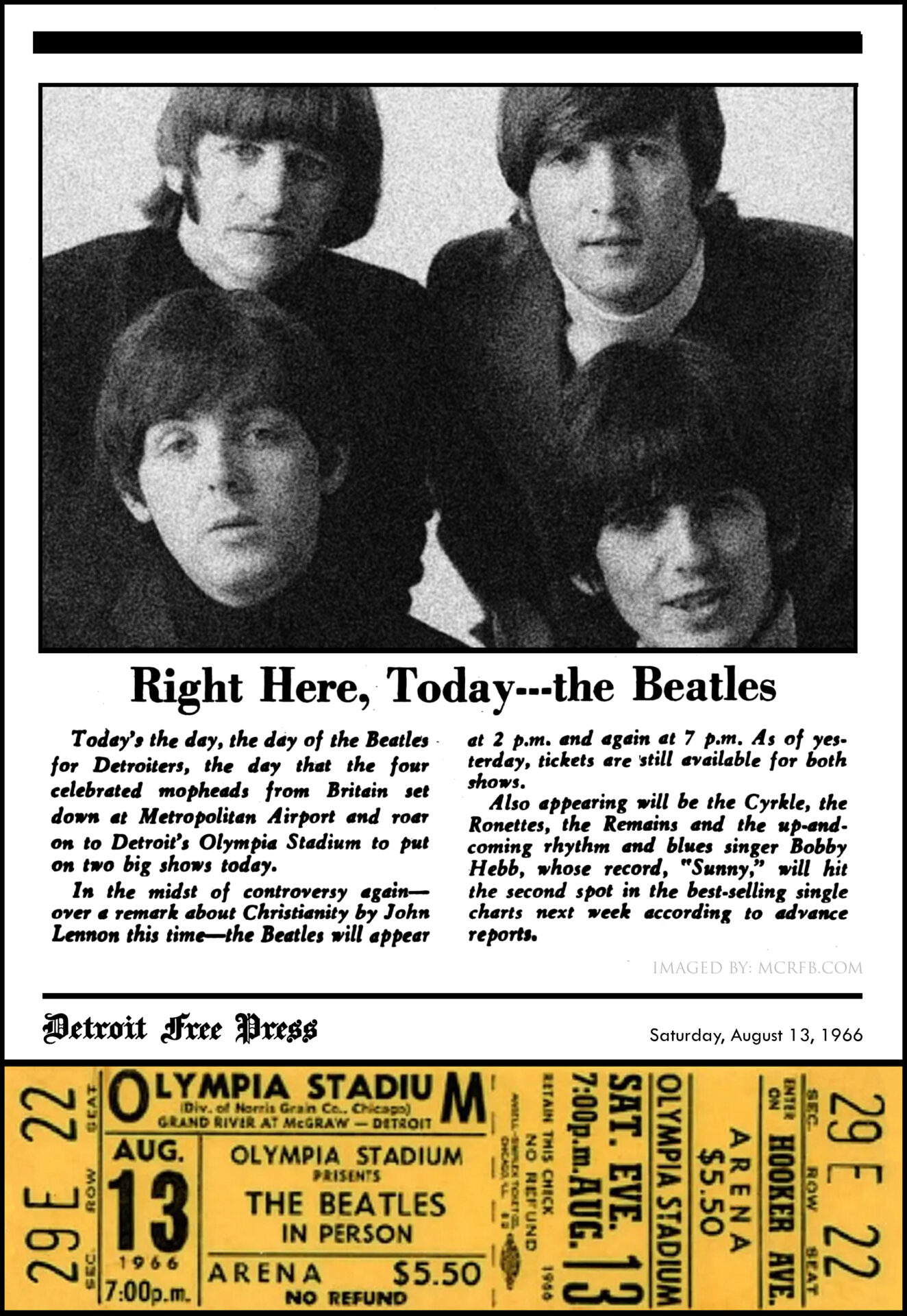 75 Years Ago, This Month, Broadcasting Magazine Reported In-Depth On the Status of the Radio Market in Detroit — Part 2
75 Years Ago, This Month, Broadcasting Magazine Reported In-Depth On the Status of the Radio Market in Detroit — Part 2
Note: Missed Chapter One? Go HERE.
_____________________
Detroit is a city of many stories. It is the story of the gigantic auto plants that are within its boundaries and in the cities that surround it; of the thousands of tool and die shops; of the deep-laden lake freighters hauling iron ore down the river, and coal back up; of the drug industry; the stove works; the deep salt mines on the edge of the city.
But most of all it is the story of rows of homes, each with its backyard and front lawn, where friendly families talk across back fences and by the garages that hold the family cars. For Detroit not only believes in making cars, it also believes in buying them. In 1948 there were 551,000 passenger car registrations in Wayne County, which means that, with a little squeezing, the entire population could have been car-borne. Cars also accounted for the greatest single retail sales total, coming to $440 million.
 A retail market the size of Detroit builds big business, and one of the city’s biggest is the mammoth J. L. Hudson Co. – now the largest in gross sales in department stores under one roof. Though it is also a tremendous buyer of white space, Hudson qualifies as one of the oldest consistent radio time buyers in the area.
A retail market the size of Detroit builds big business, and one of the city’s biggest is the mammoth J. L. Hudson Co. – now the largest in gross sales in department stores under one roof. Though it is also a tremendous buyer of white space, Hudson qualifies as one of the oldest consistent radio time buyers in the area.
[Note: Mouse click over (pc) or tap and stretch (mobile screen) over the WWJ ad image for largest detailed read.]
For 15 years it has sponsored the early morning Minute Parade on WWJ, devoted to classical and semi-classical music. Another program on the same station is Home Making Highlights, devoted entirely to promotion of the store’s 10th floor where items for the home are sold. Rounding out its AM schedule is the Don Wattrick Sports Show on WXYZ three times per week.
The store waited even less time to get into television. It was one of the first advertisers on WWJ-TV, and its Sketchbook show is the oldest sponsored program in the area, having celebrated its second birthday in May. Still another TV offering is Man’s World on WXYZ-TV, a 15- minute show featuring topics of masculine interest. All of the programs are produced by Wolfe Jickling-Conkey with the exception of Minute Parade which is placed direct. Jim Christensen, radio and television director for the agency, directs them. Ralph L. Wolfe, agency president, heads the Michigan chapter of the AAAA.
But the first and foremost in the Detroit picture are the automobiles, and radio advertising budgets devoted to their sale. The use of radio by the automobile industry has been a sporadic one, marked by fine selection of new programs, developing them into national prominence, and then unexplainedly dropping them in time for some other sponsor to reap the harvest. But there are indications that the picture is changing, and it is perhaps worthy of note that the agencies handling auto accounts, both local and national, are all radio minded. Especially do the motor makers seem intrigued by television, for their cry has always been (even if mistakenly), “We’ve got to show ’em, to sell ’em!”
One of the oldest sponsor-client relationships in Detroit is that of Campbell-Ewald Co. and Chevrolet. At one time this agency had the entire General Motors billing, and when GM decided to split up the business, C-E chose to retain Chevrolet. Radio activity centers on this account, for the agency places time for many of the dealer organizations as well as the manufacturer. Chevrolet has been sponsoring the NBC-TV show, Chevrolet On Broadway, a half-hour drama. In January the auto maker had an all-out spot campaign to introduce new models, using three spots a day on 450 outlets for three consecutive weeks. Some 300 of these were factory buys all over the country, and 150 were dealer purchases in 14 metropolitan areas. Henry G. Little, executive vice president of the agency, handles this account.
The Detroit Chevrolet dealers are quite active, too, using two spots per day on four local stations, plus the Sunday half-hour of Ziv’s Wayne King show. To support the market for trucks, Chevrolet is beginning a spot campaign of indefinite length on 350 stations. Plans call for one spot per day on each outlet. Henry T. Ewald, founder of Campbell-Ewald, is president and chairman of the board. He is also founder of Detroit’s Adcraft Club. Another facet of the Chevrolet story is that of individual dealers. One, Grand River Chevrolet, is using TV spots now, through the W. B. Doner agency, and plans a TV variety show in the fall. Another, P. L. Grissom, is buying the AM broadcasts of the horse races from Detroit’s Fair Grounds, through Luckoff, Wayburn & Frankel.
Right down the hall in the General Motors Bldg. is the D. P. Brother agency, handling the Oldsmobile account. Olds also is using television, in addition to a steady radio schedule promoting the 1949 Futuramie models. It sponsors the Douglas Edwards news program three times weekly over CBS-TV, utilizing eight stations in a 52-week buy. In addition, 160 AM stations are sharing in a constant campaign of musical spots, featuring the tune that Olds must have given thanks many times for, “In My Merry Oldsmobile.” Mr. Brother is president of the agency, with Clarence Hatch Jr. as executive vice president and account executive on Olds. Carl Georgi Jr., also a vice president, buys all radio time.
Across the street from the General Motors Bldg. in the Fisher Bldg., which houses WJR, is another agency that goes back more than 30 years – MacManus, John & Adams. The late Theodore MacManus, founder of the firm, was voted into advertising’s Hall of Fame at the recent meeting of the Advertising Federation of America, for his services in pioneering in the field of automotive advertising. One of the agency’s auto accounts, Pontiac, just finished a spot campaign on the 1949 model, but future plans have not yet been revealed. Last fall Pontiac dealers bought the AM broadcast of U. of Michigan games on WWJ.

Principal radio buy right now is the Champion Spark Plug sponsorship of Harry Wismer’s Roll Call on 216 ABC stations. John MacManus is account executive of Champion. A local dealer, Packer Pontiac, is sponsoring a 15-minute newscast on WEXL, plus spots on several other stations. Another auto account is Cadillac, but is not a radio buyer. James R. Adams is president and W. A. P. John, who recently hit the pages of the Saturday Evening Post with an article on his recovery from a severe heart attack, is chairman of the board.
Hudson Motor Car Co. has a long history of broadcasting, including such buys as the Paul Whiteman Show. But the company had been out of network shows since 1937’s Kate Smith program until it returned this April with a 513- station, one-time buy of the entire Mutual network to celebrate its 40th anniversary. At the same time the Hudson Dealers of America launched a 700-station spot campaign that is still continuing two weeks out of each month. This cooperative program generally consists of five spots per week per outlet.
In addition, Hudson Dealers of Detroit have just picked up the tab on an across- the-board telecast of live and filmed news over WJBK-TV. The 15-minute program features commentator Larry Ruppel. The factory also is sponsoring five spots weekly on WJBK-TV and three one-minute spots on WWJ-TV and WXYZ-TV. Brooke, Smith, French & Dorrance is agency for Hudson.
The McCann-Erickson Detroit office is origination point for another auto account, Chrysler-Plymouth Dealers, buying Sammy Kaye Showroom on 364 stations, one of the largest groups ever to buy an automotive program.
Automobile plants often use spots to summon men back to work after layoffs caused by strikes or materials shortages. A heavy spot program is used the day before, on a spread of stations, listing those who are to report back and at what time. Briggs Body is a steady user of this idea through McCann-Erickson, as is Ford Motor through J. Walter Thompson. Chrysler Division of Chrysler Corp. right now is using only a one-hour disc jockey show on WJR. Paul Holder handles the C-P dealer program. MCRFB: to be continued next week . . .
 This feature is a special Broadcasting series about Detroit radio. This was first released by the publication on August 1, 1949. It will continue as an exclusive presentation every Tuesday on this site throughout August and September, for a total of six weeks.
This feature is a special Broadcasting series about Detroit radio. This was first released by the publication on August 1, 1949. It will continue as an exclusive presentation every Tuesday on this site throughout August and September, for a total of six weeks.
Originally published in Broadcasting magazine under the title “The Detroit Radio Market,” this extensive article will be presented in six parts, continuing in sequential chapters.
The 1949 article provides valuable insights into the state of radio in Detroit during the late 1940s decade, as it was, then, seven decades ago.
![]()










